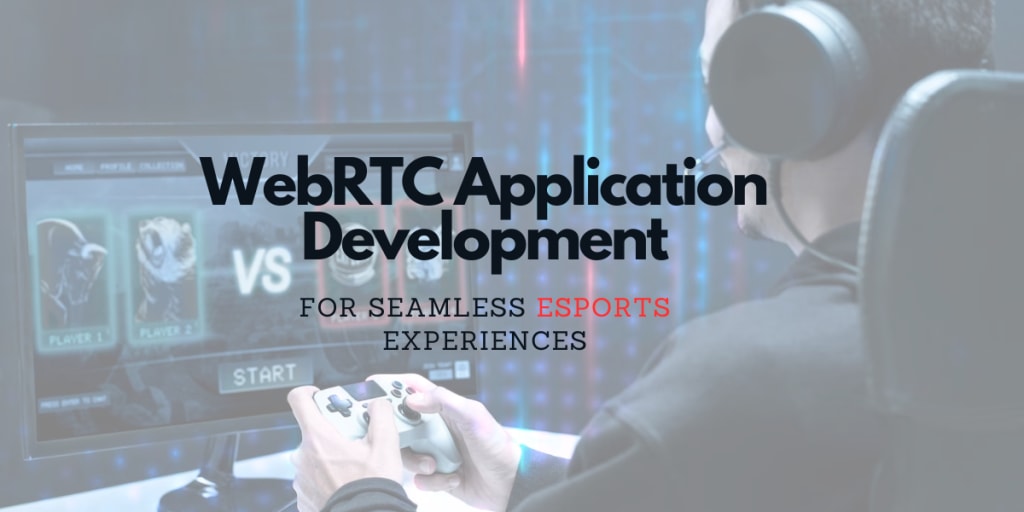WebRTC Application Development for Seamless eSports Experiences
WebRTC Application Development

The eSports industry has experienced explosive growth in recent years, becoming a multi-billion-dollar market with millions of fans worldwide. As the demand for high-quality, real-time interactions in gaming continues to rise, Web Real-Time Communication (WebRTC) has emerged as a game-changer. This technology enables seamless, low-latency communication, making it an ideal solution for enhancing eSports experiences. In this blog, we will explore how WebRTC application development is revolutionizing eSports, the benefits it brings, and best practices for implementing it.
Understanding WebRTC
A WebRTC implementation provides real-time communication functionality to web browsers and mobile applications via application programming interfaces (APIs). It supports video, voice, and generic data to be sent between peers, allowing for direct, peer-to-peer communication. This is particularly valuable in eSports, where low latency and real-time interactions are crucial.
The Role of WebRTC in eSports
- Low Latency Communication: In eSports, milliseconds can make the difference between victory and defeat. WebRTC's peer-to-peer communication model minimizes latency, ensuring that players can communicate and respond in real-time. This is essential for competitive gaming, where split-second decisions are critical.
- High-Quality Video and Audio: WebRTC supports high-definition video and audio streams, enhancing the quality of game streams and broadcasts. Players, commentators, and audiences can enjoy crystal-clear communication, improving the overall viewing experience.
- Real-Time Data Exchange: WebRTC allows for the exchange of real-time data, which can be used for in-game interactions, such as sharing scores, stats, and other critical information. This adds an extra layer of engagement and interactivity to eSports events.
- Scalability: WebRTC can handle a large number of concurrent connections, making it scalable for large eSports events. It can be integrated with Content Delivery Networks (CDNs) and other backend infrastructure to support thousands of viewers without compromising performance.
Benefits of WebRTC in eSports
- Improved Player Experience: The low latency and high-quality communication provided by WebRTC enhance the player experience. Players can communicate seamlessly, strategize in real-time, and enjoy a more immersive gaming experience.
- Enhanced Spectator Engagement: Spectators play a vital role in the success of eSports. WebRTC enables high-quality live streaming, real-time commentary, and interactive features, making the viewing experience more engaging and enjoyable.
- Cost-Effective Solution: WebRTC is an open-source technology, which means it is cost-effective to implement. It reduces the need for expensive server infrastructure and third-party communication services, making it an attractive option for eSports developers and organizers.
- Cross-Platform Compatibility: WebRTC is compatible with various platforms, including web browsers, mobile devices, and desktops. This ensures that eSports applications can reach a wider audience, regardless of the device they are using.
Best Practices for Implementing WebRTC in eSports
- Optimize for Low Latency: To fully leverage the benefits of WebRTC, it is essential to optimize for low latency. This includes choosing the right codecs, minimizing network hops, and using efficient signaling protocols. Employ techniques like Adaptive Bitrate Streaming (ABR) to adjust the quality of the stream based on network conditions.
- Ensure High Availability and Reliability: eSports events attract large audiences, and any downtime can lead to significant disruptions. Implement redundancy and failover mechanisms to ensure high availability and reliability of your WebRTC application. Use load balancers and multiple servers to distribute the load evenly.
- Prioritize Security: Security is paramount in eSports, where sensitive player data and communications are involved. WebRTC includes built-in security features, such as encryption and secure RTP (SRTP). Additionally, implement measures like authentication, authorization, and regular security audits to protect against potential threats.
- Scalable Architecture: Design your WebRTC application with scalability in mind. Use scalable architectures, such as microservices, to handle large volumes of traffic. Integrate with CDNs and cloud services to distribute content efficiently and ensure a seamless experience for all users.
- User Experience (UX) Design: A seamless user experience is critical for the success of any eSports application. Develop a user-friendly, intuitive interface with UX design. Ensure that players and spectators can easily navigate the application, access features, and enjoy a smooth experience.
Case Studies: WebRTC in Action
- Twitch: Twitch, a leading live streaming platform for gamers, leverages WebRTC to provide low-latency streaming and real-time interactions between streamers and viewers. This has significantly enhanced the engagement and interactivity on the platform, making it a favorite among eSports enthusiasts.
- Discord: Discord, a popular communication platform for gamers, uses WebRTC for its voice and video chat features. The low-latency and high-quality communication enabled by WebRTC have made Discord an essential tool for eSports teams and communities.
Future of WebRTC in eSports
The future of WebRTC in eSports looks promising. As technology continues to evolve, we can expect even lower latencies, higher quality streams, and more interactive features. Virtual Reality (VR) and Augmented Reality (AR) are also set to benefit from WebRTC, offering immersive and real-time experiences for both players and spectators.
Also Read: WebRTC Developers: 5 Reasons to Hire Them
Conclusion
WebRTC application development is revolutionizing the eSports industry by providing seamless, low-latency communication, high-quality video and audio, and real-time data exchange. Its cost-effectiveness, cross-platform compatibility, and scalability make it an ideal solution for enhancing eSports experiences. By following best practices and leveraging the power of WebRTC, developers and organizers can create engaging and immersive eSports applications that captivate players and spectators alike.
The integration of WebRTC in eSports is not just a technological advancement; it is a step towards a more connected and interactive future for competitive gaming. As the eSports industry continues to grow, WebRTC will undoubtedly play a pivotal role in shaping its trajectory.
About the Creator
Master Software Solutions
Master Software Solutions is an IT service-based company. We are a team of 90+ IT experts with more than 12 years of experience. We provide development and tech-consulting services for platforms, like HubSpot, Salesforce and WebRTC.
Enjoyed the story? Support the Creator.
Subscribe for free to receive all their stories in your feed.






Comments
There are no comments for this story
Be the first to respond and start the conversation.